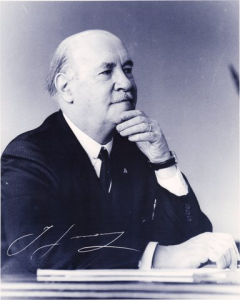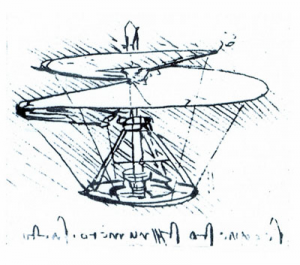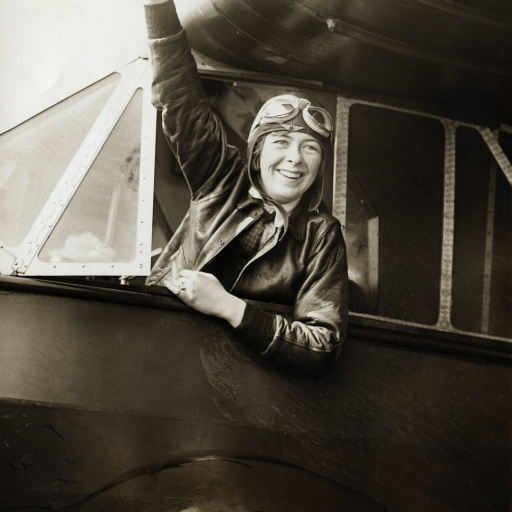Igor Sikorsky
Inspiring Quotations

Igor’s dream of aviation began at the age of 11 years. That statement of the dream is quoted from Chapter 1 of his autobiography – “The Story of the Winged – S.”
“During the year 1900, at the age of about 11 years, I had a wonderful dream. For several days I lived under the impression of that dream and have always remembered the details.
I saw myself walking along a narrow, luxuriously decorated passageway. On both sides were walnut doors, similar to the state room doors of a steamer. The floor was covered with an attractive carpet. A spherical electric light from the ceiling produced a pleasant bluish illumination. Walking slowly, I felt a slight vibration under my feet and was not surprised to find that the feeling was different from that experienced on a steamer or on a railroad train. I took this for granted because in my dream I knew that I was on board a large flying ship in the air. Just as I reached the end of the corridor and opened a door to enter a decorated lounge, I woke up.
Everything was over. The palatial flying ship was only a beautiful creation of the imagination. At that age I had been told that man never produced a successful flying machine and that it was considered impossible.”
“Impossible” but not to Igor Sikorsky who went on to distinguish himself in three different aeronautical fields – large multi-engine aircraft, transoceanic flying boats and helicopters.
To feel the depth of this aviation pioneer we have compiled below a sampling of the comments of Igor I. Sikorsky on aviation and engineering, culled from his writings, speeches, interviews and several unpublished manuscripts. Minimal editing was exercised, so as to preserve the exact words and the accent as much as possible.

"We were ignorant, and we were ignorant of the fact that we were ignorant! This was ignorance squared, and it often led to disaster."

"Throughout 1910 and 1911, I followed the intensely interesting and romantic road of the early pioneers who built their machines without knowing how to build them and then climbed into the cockpits to try to fly their aircraft without knowing how to fly..!"

"In the pioneering days, self training, both in engineering problems and in piloting, was an important condition of success and even survival."
"There was also the comforting realization that nearly all discoveries were preceded by numerous failures."

"In those early days, the Chief Engineer was almost always the Chief Pilot as well. This had the automatic result of eliminating poor engineering very early in aviation."
"I will admit that a great deal of the design of these early aircraft were based on pure guess work. We had little except the flight of birds to turn to for information."
"For take-off, some friends or spectators held the tail. We fiddled with the needle-valve and spark to get maximum rpm for that particular day. Then they let go and off you went. You did not touch engine controls in flight. Most of the landings were when the aircraft decided to land, not the pilot."

"It was on this aircraft (S-5) that I succeeded to teach myself to fly, first by running and making a considerable number of short, straight-line hops and finally making my first circle in the air."
"On the S-5, I sat entirely in the open just above and behind the lower wing. The view was free in nearly all directions, including straight down."
"The work of a pioneer in science of technique often consists of finding a correct solution, or creating a working mechanism, based on laws that are not yet discovered."
"It was a unique aircraft...It took off at a speed of 60 miles per hour, cruised at 60 miles and stalled at 60 miles!"
"We knew we were building a light structure (the S-21 Grand), but it seemed more productive to fly prudently at a load factor of 2 than to roll safely along the ground at a load factor of 3."
"It was only a few years ago that a pilot who had an altimeter, a tachometer, an air speed indicator, and a fuel gauge was thought to have extremely good equipment."

"In America I found the confirmation of my hopes and came to understand the reason for the success of this country. Nothing can equal free work of free men. This is the foundation upon which the indisputable success of the United States has been built."

"Money lost-nothing lost, Health lost-little lost, Spirit lost-everything lost."
"I have been hungry in America. I have known what it is to seek for work and not find it in America. But there was never a day during the hardest times that I have lost hope in my planes or that I did not say aloud, "Thank God I am here, a free man, breathing free air. No man can order what I do. If I fail, I can try again!"

"At that time aviation was very dangerous and the greatest danger was starvation. The best chance for a good meal was an invitation as an after dinner speaker."
"Young man, when I started to fly, we did not know if the airplane or the pilot was capable of flight. In your case, 50% of the problem has been solved"
"It is much better to learn (flying) while young. One is so unaware of what is impossible."

"America can be proud of the pioneering period, which (the Wright brothers) started, was completed and closed by another great American, Charles Lindbergh, and his wonderful flight of May 21, 1927. Before his flight, aviation was a hobby...after his flight, it became a profession."

"The aeronautical engineer always struggles with what might be termed a three-cornered problem. He must get speed, load capacity, and flying range and to accent any one, he must sacrifice the other."
"According to the laws of aerodynamics, the bumblebee can't fly, but the bumblebee doesn't know the laws of aerodynamics, so it goes ahead and flies."

"Never promise a customer anything you are not sure you can achieve."
"Truth in politics is optional - Truth in engineering is mandatory."
"We feel justified in considering the American Clipper (S-40) the forerunner of a series of other glorious clipper ships that established American airline operation across all the oceans."

In response to a request from the Associated Press on April 20, 1941 as part of “I am an American Day” Igor responded as follows:
"I am happy to be an American because this great country is the stronghold of liberty and progress; because here each citizen can arrange his life and family as he wants; can express freely any beliefs or opinions that he may have without fear of persecution or intimidation. I am proud to be an American because this great country always has been the traditional carrier of idealism, good will, and help all over the world wherever there is need or suffering. For myself and my four American-born sons, I am happy and proud to be a citizen of this great, powerful, free country that has no reason to envy or fear any country in the world."

"Here in America, I found the confirmation of my hopes and came to understand the reason for success of this great country - It was the free initiative and free work of a free people. It was the result of the fundamental idea of...'Life, Liberty, and the Pursuit of Happiness...'. This has been, and still remains, the wisest and most constructive formula upon which a free, progressive, and successful human society can be founded."
"A flying machine rising directly from the ground by the action of a lifting propeller was most appealing to my imagination."

"The whole art of aeronautics, all of man's accumulated experience in mechanical flight, has contributed to the development of direct-lift operation."
"The helicopter approaches closer than any other (vehicle) to fulfillment of mankind's ancient dream of the flying horse and the magic carpet."

"In September (1939), the helicopter made its first flight. The "first flight" is somewhat of an ambitious term, but anyway the ship is off the ground probably 3" to 5" high, probably for a few seconds... that was all."
"During the very earliest flight we extensively used slow motion (filming) and this was for two reasons. One- the ship...was rather unsteady and the slow motion changed this to a considerably less risky and less bumpy flight. Another thing...due to slow motion the very short flights looked much longer - about twice longer - which was good. Now, a little later, the slow motion no longer was necessary because we could produce reasonably long flights."

"It would be right to state that, with the successful flight of the XR-4 in the summer of 1942, the helicopter became a reality in the United States."
"For me, the greatest source of comfort and satisfaction is the fact that our helicopters have saved up to the present time (1969) over fifty thousand lives and still continue with their rescue missions. I consider this to be the most glorious page in the history of aviation." (Today, as of 2012, the number is close to two million lives saved.)

"The many interesting flight activities and great variety of service rendered by the helicopter are well known, the most important being the saving of many thousands of lives."
"It would be right to say that the helicopter's role in saving lives represents one of the most glorious pages in the history of human flight"
"We, the designers and builders of airplanes, would be building something useless and worthless if it wouldn't be for the skill and courage of our airmen."
"If a man is in need of rescue, an airplane can come in and throw flowers on him, and that's just about all. But a direct lift aircraft could come in and save his life."
